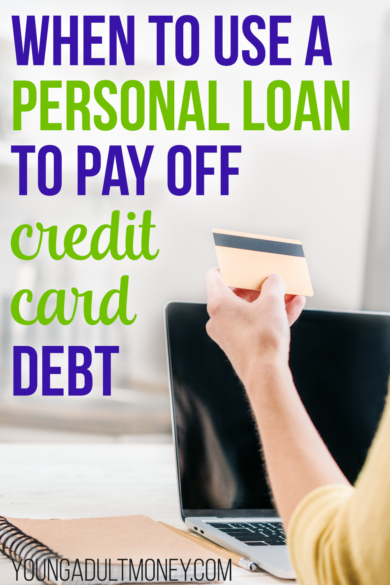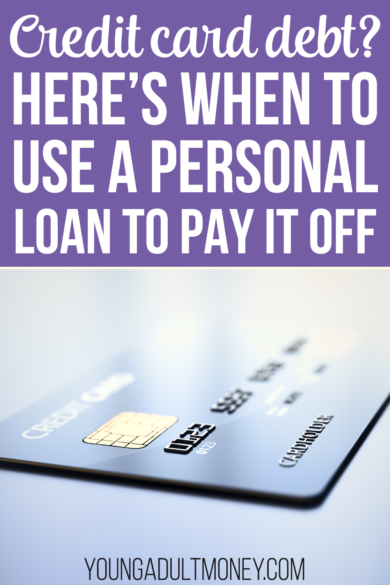 Credit card debt can be tough to deal with.
Credit card debt can be tough to deal with.
Credit card debt typically comes with a high interest rate, and it can be difficult to make a dent in the balance.
In an effort to pay off credit card debt sooner than later, many people opt to take out a personal loan to pay off their card debt.
But is this a good option for you? Here’s what you need to know about paying off credit card debt with a personal loan – as well as a second option that you may or may not have considered.
What is a Personal Loan?
A personal loan is money lent by a bank or online lender. With a personal loan, you typically are approved to borrow up to a certain amount, and then pay it back to the bank in fixed monthly payments. Just like credit card debt, you pay back the entire loan amount plus interest.
Personal loan interest rates vary, but range from less than 5% to 20%+ APR. Approval for the loan amount and interest rate depends on a variety of factors, including credit score, debt-to-income ratio, the lender, and how much is being borrowed.
The primary difference between a personal loan and credit card debt is two-fold:
- Payback Terms – One reason credit card debt can be so devastating is because you don’t have to pay it back in a defined term. There is a minimum payment you must make, but that can be relatively small compared to the balance. If you only pay the minimum for a long period of time you will end up paying back much more than you originally charged on the card.
With a personal loan you have consistent required payments and, most importantly, an end date. If the personal loan doesn’t have an early payment penalty you can speed that date up further by making extra payments.
- Interest Rate – Besides having a defined end date, the primary reason people use a personal loan to pay back credit card debt is because the interest rate is almost always significantly lower. For example, if you received a rate of 10% for a personal loan you would have significant interest savings compared to keeping the credit card debt, which will typically be in the 20%+ range.
Is a Personal Loan Better than Credit Card Debt?
It may seem contradictory to take out debt to pay off debt, but there is one major advantage of taking out a personal loan to pay off credit card debt – interest rate.
Credit cards usually have much higher interest rates than a personal loan. The average credit card interest rate is approximately 16%, but many cards are closer to 20%. So, if you are able to secure a personal loan for, say, a 5%-10% interest rate, you can drastically lower the amount you pay in interest.
Curious what rate you could get? Credible compares rates from over 10 different lenders. Get a free rate quote on their site (checking rates does not affect your credit).
Should You Take Out a Personal Loan to Pay Off Credit Card Debt?
If you are able to make your payments on time and secure a low interest rate, then you may want to consider paying off your credit card debt with a personal loan.
One important difference to note is credit card debt is called revolving debt, meaning you are only required to make the minimum payment. In contrast, with a personal loan, you must pay the entirety of the installment every month. However, if you’re able to pay the full monthly installment, then using a personal loan to pay off higher interest credit card debt would be an excellent option.
How to Use a Personal Loan to Pay Off Credit Card Debt
The first step to paying off your credit card debt is to secure a personal loan. Since interest rates can vary drastically, it’s a good idea to get a few quotes to ensure you find the best possible deal.
To make it easy on yourself, use an online marketplace like Credible, which provides borrowers with competitive and personalized loan offers from multiple lenders. The nice thing about using a service like Credible is you only have to fill out one form instead of submitting separate applications for each lender. You can then easily compare lenders to see who is offering the best rates and terms.
Once you open a personal loan, you then must make the monthly payments to your new lender. Most of the time, lenders allow you to set up an automatic payment, so you just need to be sure you have enough money to cover the entirety of the payment each month.
Another Option: 0% APR Balance Transfer Credit Card
One solid alternative is a balance transfer credit card. With a balance transfer card, you transfer your existing credit card balance onto a new credit card with 0% APR for a defined period of time.
To see how this works, say you have a $5,000 balance on a credit card with a 15% interest rate. A large portion of every payment you make is going towards interest. To lower the amount you pay in interest, you decide to shop around for a credit card that offers an introductory 0% interest rate for the first year.
You open a new credit card and then pay off your original credit card with your new card. You now have a $5,000 balance on your 0% APR card. You then have one year (or whatever the term is, typically 12+ months) to pay off your $5,000 balance before your interest rate increases from the 0% introductory offer.
At least in theory a 0% balance transfer credit card makes more sense than a personal loan. With a personal loan you will still have a portion of your payment going towards interest. With a balance transfer credit card you will have months and months of 0% interest.
But this assumes two things: that your application for the balance transfer credit card is accepted, and that you actually pay off a large portion (or ideally all) of your debt before the 0% introductory period ends.
Needless to say, the risk with a balance transfer is you have to be committed to paying off your debt in order for it to work. Otherwise, your debt will continue to balloon if you surpass the initial introductory period offered by the new credit card. However, if you’re diligent in creating your own payment plan and sticking to it, you may want to consider doing a balance transfer.
Which is the Best Option for You?
Ultimately, deciding the best way to pay off your credit card debt is entirely up to you. But before you make a decision, it’s vital to consider your financial habits. When done correctly, using a personal loan to pay off credit card debt can save you hundreds, if not thousands of dollars in the long run. The same can be said of 0% APR balance transfer credit cards.
One option is consider a tiered approach. You could first give a 0% balance transfer credit card a try. If you are unable to pay off all the debt during the introductory period, you could take what remains and pay it off with a personal loan.
Similar to refinancing student loan debt, we recommend people get rate quotes at least every 6-12 months to see if a better offer is available. Let’s say you took out a personal loan a year ago and got an 11% APR. If you look again and find offers for, say 8% APR, it totally make sense to refinance (assuming no early payment penalty for the 11% APR loan – which is likely the case but always read the fine print).
Click the options below to get free personal loan rate quotes on Credible (remember – getting a rate quote does not impact your credit) or browse 0% APR balance transfer credit cards.


